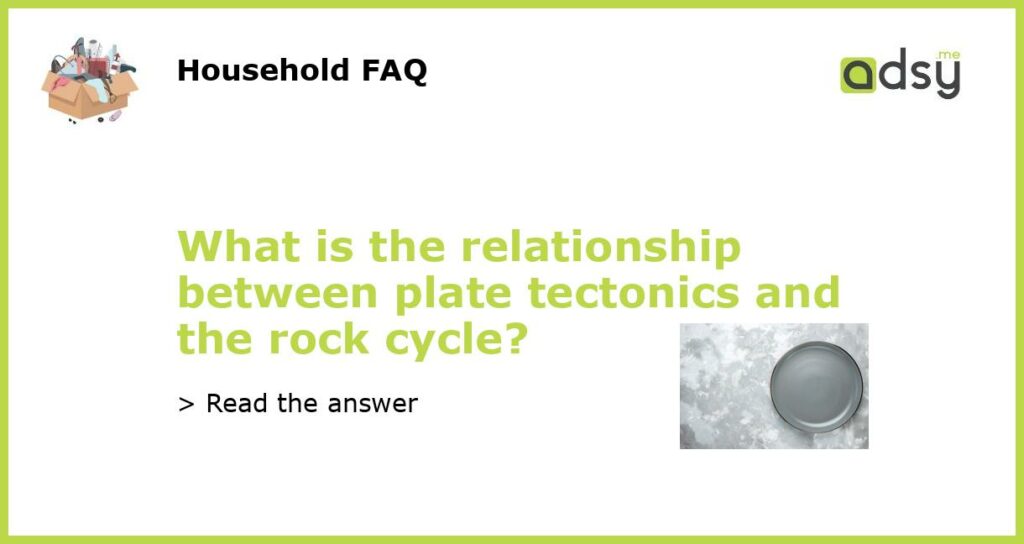Plate tectonics: The driving force behind the rock cycle
Plate tectonics and the rock cycle are two fundamental concepts in geology that are intrinsically connected. Plate tectonics is the theory that explains the large-scale movement of the Earth’s lithosphere, which is made up of several tectonic plates. On the other hand, the rock cycle describes the continuous transformation of rocks through various geological processes.
Plate tectonics: Shaping the Earth’s crust
Plate tectonics is driven by the convection currents in the Earth’s mantle, which cause the tectonic plates to move. These plates interact at their boundaries, resulting in various geological phenomena such as earthquakes, volcanic activity, and the creation of mountain ranges. These dynamic processes are directly involved in the rock cycle.
Rock cycle: A continuous process
The rock cycle describes the interplay between three main types of rocks: igneous, sedimentary, and metamorphic. It illustrates how rocks are continually transformed from one type to another over long periods of time.
The cycle begins with the formation of igneous rocks through the solidification of molten material, either below the surface (intrusive igneous rocks) or on the surface (extrusive igneous rocks). Over time, the exposure to weathering and erosion breaks down these rocks into sediments.
These sediments then undergo lithification, a process that compacts and cements them together to form sedimentary rocks. This can occur through deposition in bodies of water, such as rivers or oceans, or through the accumulation of wind-blown particles. Sedimentary rocks can also form from the consolidation of organic material, such as in the case of coal.
When sedimentary rocks are subjected to heat and pressure within the Earth’s crust, they undergo metamorphism, resulting in the formation of metamorphic rocks. This process causes the minerals within the rocks to recrystallize, changing their texture and often their chemical composition. Metamorphic rocks can be further transformed through the melting of minerals, which leads to the formation of new igneous rocks.
The role of plate tectonics in the rock cycle
Plate tectonics plays a significant role in driving the various processes of the rock cycle. The movement and interactions of tectonic plates influence the distribution of igneous, sedimentary, and metamorphic rocks throughout the Earth’s crust.
Volcanic activity, which occurs primarily at plate boundaries, contributes to the formation of igneous rocks. When magma rises to the surface through volcanic eruptions, it cools and solidifies, eventually forming new igneous rocks. The Hawaiian Islands, for example, are a result of the continuous volcanic activity along the Pacific Plate.
The subduction of one tectonic plate beneath another can lead to the formation of metamorphic rocks. The immense heat and pressure generated during this process cause the existing rocks to undergo structural and chemical changes, resulting in the formation of new metamorphic rocks. The Himalayas, the tallest mountain range on Earth, are the product of the collision between the Indian Plate and the Eurasian Plate.
Sedimentary rocks can also be formed as a result of plate tectonics. The constant movement and interaction of plates create uplift and subsidence of land, leading to the formation of basins and sedimentary deposits. The deposition and lithification of sediments in these basins eventually form sedimentary rocks such as sandstone, limestone, and shale.
A feedback loop between plate tectonics and the rock cycle
The relationship between plate tectonics and the rock cycle is not a one-way street; it is a feedback loop. The processes of the rock cycle, such as the formation and erosion of rocks, can also influence plate tectonic activity.
For example, the subduction of oceanic lithosphere beneath continental lithosphere is a process that can trigger volcanic activity. As oceanic lithosphere descends into the mantle at subduction zones, it undergoes partial melting due to the increase in temperature and pressure. This molten material, known as magma, rises towards the surface and can lead to the formation of volcanoes. The Pacific Ring of Fire, a region characterized by intense volcanic and seismic activity, is a result of the subduction of the Pacific Plate beneath other tectonic plates.
Furthermore, the erosion of rocks by wind, water, and glacial activity can transport sediments to the ocean. The accumulation of these sediments at the continental margins can result in the increased weight and bending of the lithosphere. This can cause the lithosphere to sink into the asthenosphere, a process known as isostatic adjustment. The sinking lithosphere can then induce the upwelling of magma, leading to volcanic activity.
In conclusion, plate tectonics and the rock cycle are intimately linked in the Earth’s geological processes. Plate tectonics drives the movement of tectonic plates, resulting in various geological phenomena that play a crucial role in the formation and transformation of rocks. At the same time, the rock cycle, with its continuous transformation between igneous, sedimentary, and metamorphic rocks, influences plate tectonics through processes such as volcanic activity and isostatic adjustment.






